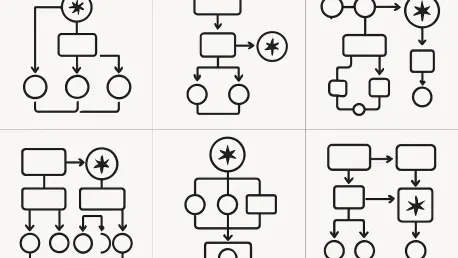Imagine a scenario where a data engineering team struggles to manage a sprawling web of complex data workflows, spending countless hours debugging dependencies and optimizing performance manually. In the realm of big data, such challenges are all too common, often leading to delays in delivering critical insights. The introduction of Apache Spark 4.0, with its groundbreaking declarative pipelines, offers a transformative solution to these persistent pain points. This guide explores best practices for adopting this innovative framework to streamline pipeline development and enhance efficiency in data processing tasks.
The significance of adopting best practices in this context cannot be overstated. Declarative pipelines shift the focus from tedious, step-by-step coding to defining desired outcomes, allowing systems to handle the intricacies of execution. By following structured approaches, data engineers and scientists can reduce operational overhead, improve collaboration, and accelerate time-to-insight for their organizations.
This guide aims to provide actionable strategies for harnessing the full potential of this framework. From understanding core concepts to implementing practical solutions, the following sections outline a clear path toward mastering declarative data workflows in Spark 4.0.
Core Principles for Adopting Declarative Pipelines
Transitioning from Imperative to Declarative Approaches
A fundamental best practice is to embrace the shift from imperative to declarative programming when building data pipelines. In traditional Spark workflows, using languages like Scala or Python, every transformation step must be explicitly coded, often leading to extensive manual effort in managing dependencies and incremental updates. Recognizing the limitations of this approach—such as the burden of maintaining complex “glue code”—is the first step toward simplification.
Declarative pipelines, by contrast, prioritize defining the end goal rather than the process to achieve it. A key recommendation is to leverage this paradigm by specifying high-level data flow requirements, allowing Spark 4.0 to optimize execution automatically. This not only minimizes coding errors but also frees up valuable time for focusing on business logic over technical minutiae.
To implement this effectively, teams should start by mapping out existing imperative pipelines and identifying repetitive or error-prone tasks. Gradually refactoring these into declarative specifications ensures a smoother transition while highlighting immediate benefits like improved readability and reduced maintenance overhead.
Mastering Key Components and Abstractions
Understanding and utilizing the core components of declarative pipelines in Spark 4.0 is essential for success. At the heart of this framework are pipelines, which act as the primary unit for encapsulating data transformations and dependencies in a directed acyclic graph. A best practice is to design pipelines with clear, modular structures, ensuring each component—such as tables or views—serves a distinct purpose within the overall workflow.
Another critical element involves distinguishing between batch and streaming flows. For batch processing, which handles static datasets, the advice is to define materialized views that can be refreshed efficiently based on upstream changes. For real-time needs, streaming flows tied to streaming tables should be prioritized to process incoming data incrementally, maintaining low latency for time-sensitive applications.
Teams are encouraged to document the purpose and scope of each pipeline component thoroughly. This practice fosters better collaboration across departments and ensures that future modifications or debugging efforts are grounded in a clear understanding of the pipeline’s intended functionality.
Optimizing with Streaming Tables and Materialized Views
Harnessing streaming tables and materialized views effectively can significantly boost performance. Streaming tables, designed for append-only data sources, enable efficient incremental processing, making them ideal for real-time data ingestion. A best practice is to configure these tables for scenarios where continuous updates are critical, ensuring minimal latency in data availability.
Materialized views, on the other hand, store precomputed results and support incremental updates, enhancing query performance for complex aggregations. The recommendation here is to strategically deploy materialized views for frequently accessed data summaries, reducing the need for repetitive computations. For instance, a retail company might use streaming tables to ingest live sales data and materialized views to maintain daily sales aggregates for quick reporting.
To maximize benefits, it’s advisable to monitor the refresh cycles of these components closely. Adjusting update frequencies based on data volatility and query demands ensures optimal resource utilization, preventing unnecessary recomputations while keeping insights current.
Practical Implementation Strategies
Building a Declarative Pipeline Step by Step
Creating a declarative pipeline in Spark 4.0 begins with a structured approach to initialization and configuration. A best practice is to use the provided “spark-pipelines” script to set up a sample project, such as a basic “helloworld_app,” which offers a practical starting point. This involves generating essential files like “pipeline.yml” to define the pipeline’s structure and transformations.
Once the project is initialized, the next step is to define data views using either Python or SQL, based on team expertise and project needs. For example, a Python script might create a materialized view with a simple range of data, while a subsequent SQL definition could filter this data for specific criteria, such as even numbers. The key practice here is to keep definitions concise and focused, ensuring each transformation aligns with the pipeline’s overarching goal.
Finally, running the pipeline with the appropriate command and analyzing the output is crucial. Reviewing the resulting data, often stored in formats like parquet files, helps validate the pipeline’s logic. A recommended habit is to log observations from each run, noting any discrepancies or performance bottlenecks for iterative improvement.
Analyzing and Refining Pipeline Outputs
Post-execution analysis forms a cornerstone of effective pipeline management. After running a sample pipeline, examining the output—such as the data stored in materialized views—provides insights into transformation accuracy. A best practice is to cross-check results against expected outcomes, ensuring that data integrity is maintained across each stage of the workflow.
Refinement is equally important. If a pipeline’s output reveals inconsistencies, such as missing or incorrect data in views, the advice is to revisit the transformation definitions for clarity and correctness. Adjusting configurations within the pipeline specification file can often resolve such issues, streamlining data flow and enhancing reliability.
Documenting findings from output analysis also proves invaluable. Maintaining a record of pipeline performance over multiple runs helps identify patterns or recurring issues, guiding long-term optimization efforts. This practice ensures that pipelines remain robust and adaptable to evolving data requirements.
Impactful Adoption and Long-Term Considerations
Looking back, the adoption of declarative pipelines in Apache Spark 4.0 marked a significant turning point for data engineering teams. The framework’s ability to simplify pipeline authoring, automate optimization, and improve maintainability redefined how complex data workflows were managed. By focusing on desired outcomes rather than execution details, teams achieved greater efficiency and collaboration.
For those embarking on this journey, the next step involves exploring the open-source resources available within the Spark ecosystem for early testing and experimentation. A practical approach is to start with small, non-critical projects to build familiarity with declarative concepts before scaling to larger, mission-critical pipelines. This gradual integration helps mitigate risks associated with compatibility or learning curves.
Beyond immediate adoption, long-term success hinges on continuous learning and adaptation. Teams are advised to stay engaged with community updates and contribute feedback to shape the framework’s evolution. By aligning declarative pipeline strategies with organizational data goals, businesses position themselves to unlock sustained value from their data assets over time.









